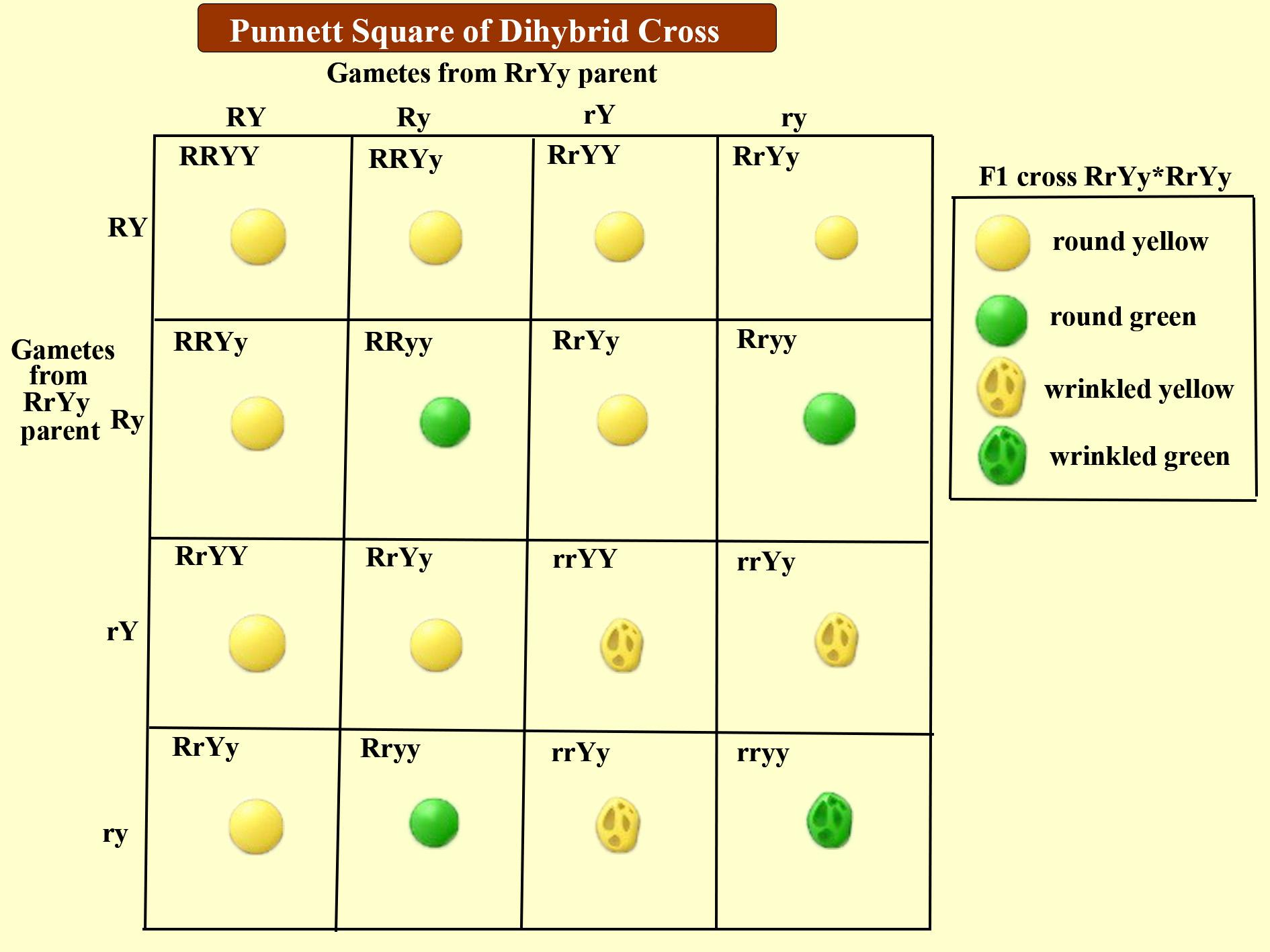
Describe the dihybrid cross experiment performed by Mendel. Explain the law postulated by this experiment.
Answer
483.3k+ views
Hint: Dihybrid cross is a cross involving crossing 2 characters at a time like Mendel crossed yellow colored round seeded plants with green colored wrinkled seeded plants; thereby observing two characters in a single cross. When characters are taken in pairs then also in a cross, the characters separate independently i.e., the cross of one character is not influenced by the crossing of other characters.
Complete answer:
Dihybrid cross performed by Mendel included yellow colored round seeded plants(RRYY) and green colored wrinkled seeded plants(rryy). When Mendel crossed these plants he obtained a progeny (RrYy) in the F1 generation which was phenotypically a yellow colored round seeded plant. When he self crossed this plant obtained in the F1 generation (RrYy) he obtained 4 phenotypically different plants- yellow colored round seeded (RRYY/RrYy), yellow-colored wrinkled seeded (YYrr/Yyrr), green-colored round seeded plants (yyRR/yyRr), and green colored wrinkled seeded plants (rryy) as shown in the figure. From this experiment, Mendel derived the third law, the law of independent assortment. This law explains to us that whenever two characters (or factors as said by Mendel) are taken at one time, they separate independently, the separation of one character is not affected by the other character and vice-versa. Phenotypically, the dihybrid cross gave a ratio of 9(yellow colored, round seeded) :3 (yellow-colored, wrinkled seeded) :3 (green colored, round seeded):1 (green colored, wrinkled seeded). Genotypically, the ratio is 1:2:2:4:2:1:2:1.

Mendel gave three laws- the law of dominance, the law of segregation, and the law of independent assortment. The law of dominance states that one of the traits of a character will be dominant and the other would be recessive. The recessive does not express itself until it is present in homozygous condition. The law of segregation states that alleles are distributed randomly in the gamete. An offspring receives one allele from each parent which is passed on from the parent randomly for a particular trait.
Note: Only the law of segregation is universal whereas the law of dominance and law of independent assortment have their exceptions. The Law of independent assortment has exceptions which lead to incomplete dominance and codominance. The law of dominance has an exception in the case of Mirabilis jalapa.
Complete answer:
Dihybrid cross performed by Mendel included yellow colored round seeded plants(RRYY) and green colored wrinkled seeded plants(rryy). When Mendel crossed these plants he obtained a progeny (RrYy) in the F1 generation which was phenotypically a yellow colored round seeded plant. When he self crossed this plant obtained in the F1 generation (RrYy) he obtained 4 phenotypically different plants- yellow colored round seeded (RRYY/RrYy), yellow-colored wrinkled seeded (YYrr/Yyrr), green-colored round seeded plants (yyRR/yyRr), and green colored wrinkled seeded plants (rryy) as shown in the figure. From this experiment, Mendel derived the third law, the law of independent assortment. This law explains to us that whenever two characters (or factors as said by Mendel) are taken at one time, they separate independently, the separation of one character is not affected by the other character and vice-versa. Phenotypically, the dihybrid cross gave a ratio of 9(yellow colored, round seeded) :3 (yellow-colored, wrinkled seeded) :3 (green colored, round seeded):1 (green colored, wrinkled seeded). Genotypically, the ratio is 1:2:2:4:2:1:2:1.

Mendel gave three laws- the law of dominance, the law of segregation, and the law of independent assortment. The law of dominance states that one of the traits of a character will be dominant and the other would be recessive. The recessive does not express itself until it is present in homozygous condition. The law of segregation states that alleles are distributed randomly in the gamete. An offspring receives one allele from each parent which is passed on from the parent randomly for a particular trait.
Note: Only the law of segregation is universal whereas the law of dominance and law of independent assortment have their exceptions. The Law of independent assortment has exceptions which lead to incomplete dominance and codominance. The law of dominance has an exception in the case of Mirabilis jalapa.
Recently Updated Pages
The correct geometry and hybridization for XeF4 are class 11 chemistry CBSE

Water softening by Clarks process uses ACalcium bicarbonate class 11 chemistry CBSE

With reference to graphite and diamond which of the class 11 chemistry CBSE

A certain household has consumed 250 units of energy class 11 physics CBSE

The lightest metal known is A beryllium B lithium C class 11 chemistry CBSE

What is the formula mass of the iodine molecule class 11 chemistry CBSE

Trending doubts
State the laws of reflection of light

One Metric ton is equal to kg A 10000 B 1000 C 100 class 11 physics CBSE

Difference Between Prokaryotic Cells and Eukaryotic Cells

What is the modal class for the following table given class 11 maths CBSE

How do I convert ms to kmh Give an example class 11 physics CBSE

Give an example of a solid solution in which the solute class 11 chemistry CBSE




